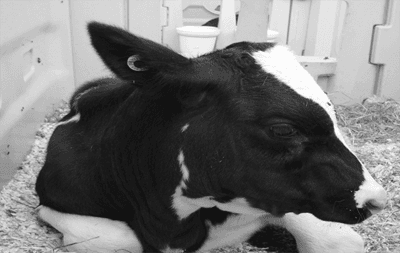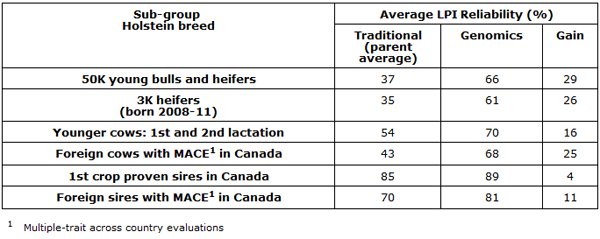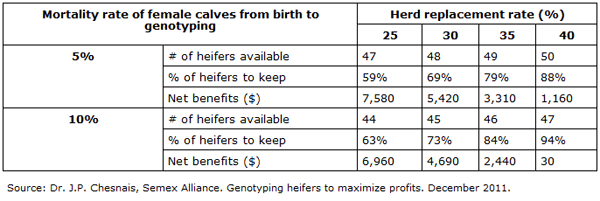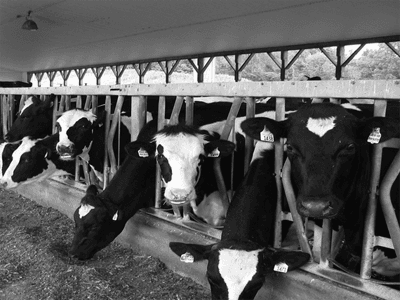genomic selection in dairy cattle
Dairy Genomic Selection
Published: August 13, 2012
By: Blair Murray - Dairy Genetic Improvement Specialist/OMAFRA
© Queen's Printer for Ontario, 2012.*
The use of genomic information in genetic evaluation has brought about revolutionary change in dairy cattle selection. Genomic evaluations increase the accuracy of genetic evaluations and have the potential to rapidly increase the rate of genetic improvement in many traits. Their use is especially effective where there is limited information such as with females and young bulls, and with traits of lower heritability.The sequencing of the bovine genome in 2004 spurred a worldwide effort to use basic information about genetic coding to improve how the genetic values of cows and bulls are estimated. The bovine genome is made up of about 25,000-30,000 useful genes. For genomic selection, the genome researchers look for markers or single nucleotide polymorphisms (SNPs). An SNP is a place in a chromosome where the DNA sequence can differ among individuals. SNPs are particularly useful when they occur on a gene or close to a gene that contributes to an important trait. As most traits are controlled by many genes, the process is complex, and real progress was not made until a genotyping computer chip, called the Illumina 50K test, was developed that could be used to identify over 50,000 SNPs on the genome.
Although the 50K test continues to be used for high-end breeding stock and screening young artificial insemination (AI) sire entries, a simpler, cheaper test called the 3K test, which identifies about 3,000 carefully chosen SNPs, has been developed to allow herd owners to make use of genomic testing on a wider basis. Provided that at least one parent has been tested with the 50K test, the more economical 3K test can be used with only a small loss in accuracy due to the use of a method called imputation, which uses knowledge of the parental genome in the calculations. Recently, more SNPs and improved accuracy have been added to the 3K test, now called the 6K test.
Tests Available
The initial genomic test available used the Illumina 50K chip, which evaluated about 54,000 SNPs that were of value on the bovine genome. This has become the accepted standard for genomic testing of AI sires, potential bull dams and screening of young sires. The cost of using this test has declined since it was first introduced, however, it is still very expensive for widespread use by dairy farmers. In 2010, Holstein Canada and the Semex Partners launched GenoTest, a program that makes the 3K test, and an even better one - the 6K test, available to Canadian dairy producers at a cost of $47 per animal.¹Although genomic testing can be carried out on a variety of tissue samples, the preferred samples are hair, including roots, or, in the case of young calves, a nasal swab. Test kits are available from Holstein Canada and the Semex Partners. Detailed instructions are available from the Holstein Canada website www.holsteincanada.ca.
Genetic improvement depends on four factors:
- selection intensity - what top percentage of selection candidates are kept as parents
- selection accuracy - how well true genetic merit can be identified
- genetic variation - how much variation there is to work with
- generation interval - how long it takes to identify superior individuals and produce offspring from them (the average age of the parents when the offspring are born)
Genomic selection improves two of these four factors: it improves the accuracy of identifying superior individuals and allows identification of superior animals early in life, shortly after they are born, shortening the generation interval.
Sire Selection
The publication of the August 2009 dairy genetic evaluations marked a new era in Canada for bull "proofs," when the majority included genomic information. With a few exceptions, all bulls available in Canada in the top 100 Lifetime Profit Index (LPI) list published by the Canadian Dairy Network (www.cdn.ca) now have genomic estimated breeding values (GEBVs) - breeding values in which genomic information was used. With proven sires, which have many daughters and a reliability over 90%, the estimated breeding value (EBV) is already a pretty accurate measure of the genetic value that a bull passes on to his offspring. For these sires, the addition of genomic information improves this accuracy only a small amount for most traits. However, the improvement can be substantial for traits with low heritability, which are difficult to evaluate accurately through traditional methods. With genomic testing, it is now possible to screen thousands of candidate young sires for AI selection and select the best possible candidates to enter the progeny testing program. This increases the selection intensity and also reduces the costs of maintaining large numbers of young sires awaiting proofs. Dairy producers can now use young sires that have genetic information (genomic parent averages or GPAs), as well as proven sires. These bulls' GEBVs are equivalent to the addition of 9-20 daughters for production and type traits in a traditional proof. They are not as accurate as a progeny proof, and breeders should use them in groups rather than trying to select one or two top bulls to use extensively. Research has shown that, in most situations, a group of five genotyped young sires has an average reliability nearly as good as that of proven bulls. A group of 10 such sires has the same average reliability as proven bulls. These young bulls, on average, can impart superior genetics as long as one does not concentrate on one particular bull, given their lower reliability. A strategy could be to use top, highly proven sires on 50% of the herd and a group of young sires on the remaining 50% of the herd. Set a limit on the number of breedings to any one sire and then replace it with a new top bull. Review the list of sires at every genetic evaluation and add and delete individuals as better bulls come along.
Figure 1. Genomic testing can be carried out shortly after birth.

An added advantage to GPAs is the availability of accurate information on individual traits. The breeder can take advantage of top young bulls that meet criteria such as calving traits and fertility, for use on heifers in the breeding program. This is an opportunity to bring the best available young genetics into the herd as quickly as possible.
Female Selection
Test cows and replacement heifers that are candidates for bull mothers, embryo transfer and/or export of genetic material with the 50K test or at least with the cheaper 6K test. The ease of use and availability as well as low cost of the 6K test makes genomic selection within herd a real possibility. Genomics are the most useful for heifers, which can be tested shortly after birth (Figure 1), allowing selection decisions and planning well in advance of their potential entry into the milking herd. Although parent averages were previously available for qualifying females, they often were not used for within-herd selection, given their low accuracy. Decisions were usually based on knowledge of the family members, the appearance of the animal or the heifer's status after one or two lactations. With heifers, a lot of culling decisions are random or depend upon the time of year the heifer calves are born or whether there is room in the milking string, therefore their selection contributes little to herd improvement. Genomics provides the opportunity to make meaningful in-herd selection decisions.
Table 1. Average gain in LPI reliability due to genomics - August 2011

Selection Within Herd
The cost of genotyping has dropped to the point where widespread testing by Canadian dairy producers using the 6K test is possible. The accuracy of heifer selection increases substantially when selection is based on genomic evaluations using the 6K test. The reliability of the genomic parent average of a genotyped heifer is more accurate than that of a non-genotyped cow with records of two or three lactations (Table 1).A number of strategies can be used in a dairy herd to take advantage of heifer genotyping (Figure 2). The greatest impact on a herd due to genomic selection comes from testing just after birth and practising selection among groups of heifers before they have their first calf. This strategy ensures that superior females enter the milking line, increasing the average genetic merit of heifers entering the milking string, as well as reducing the cost of raising replacements, typically a net cost on most farms. If it is possible to sell heifers at a premium price, a different strategy may be best. Heifers could be valued and sold based upon their genetic merit.
Using Genomic Information in Selection
Genotype all heifers shortly after birth
Modelling carried out by Dr. Jacques Chesnais and associates shows possible advantages in using heifer genotyping to select the best replacement heifers to enter a milking herd, based upon the resulting improved production of the heifers and their offspring over three lactations.
Table 2. Net current day value ($) of genotyping all available heifers in a herd of 100 milking cows and selecting the best ones based on GPA, after accounting for the cost of genotyping

Assumptions:
Net economic value: $29 per 100 points in LPI
Cost of genotyping: $47 per heifer
Calving interval: 14 months
30% of culled cows calving in current year
Inflation rate 5% to calculate net current value
Number of heifers kept: 10% above replacement rate (safety margin)
Net economic value: $29 per 100 points in LPI
Cost of genotyping: $47 per heifer
Calving interval: 14 months
30% of culled cows calving in current year
Inflation rate 5% to calculate net current value
Number of heifers kept: 10% above replacement rate (safety margin)
Table 2 shows the potential to profit from the use of genotyping according to the replacement rate in the herd and the relative number of heifers that are available from which to select replacements. Having a large number of replacement heifers increases the power of genomic selection. The number of replacement heifers available for selection can be increased by improving herd calving interval and lowering calf mortality.
Figure 2. A number of strategies can take advantage of heifer genotyping.

Table 2 shows that, with a moderate replacement rate of 30%-35%, selecting the best replacements using genotyping information is profitable. The potential return from genotyping could be from $3,300 to $5,400 in a 100-cow herd. On the other hand, if a herd has a high turnover rate and/or a low number of replacements available, heifers can be brought into the herd with little or no selection; investing in genotyping would not be worthwhile.
Sell Excess Heifers
Genotyping heifers increases the accuracy and ability to identify the top replacement heifers. Using genotyping to rank potential replacement heifers provides opportunities to keep or remove heifers early in their lives, based on their genetic value compared to the cost of raising them, estimated at $2,250, to 24 months of age. If the market value is lower than the cost of raising the heifer to milking age, the herdowner might sell excess heifers at an early age to reduce costs. If the herdowner, on the other hand, has a market for replacement heifers that returns a net profit, then heifers could be a profit centre.
Genotyping at an early age provides flexibility as to when heifers might be sold, depending upon market conditions. More information on the cost of raising heifers can be found in the OMAFRA Factsheet, The Cost of Raising Replacement Dairy Heifers, Order No. 11-055.
Genotype Only the Candidates for Culling
A lower-cost approach to genotyping replacements would be to rank all replacements according to parent average (PA), then only genotype the candidates for culling - the heifers ranked lower on the list. Make the final culling decisions using the genomic information. While this reduces the investment in genotyping, it has the disadvantage of providing no genomic information to use for management, mating decisions or sales of the better group of replacements.
Use Sexed Semen
Using sexed semen to breed replacement heifers increases the power of genotyping, as it increases the number of replacements available from which to select. According to Dr. Chesnais' research, the use of sexed semen nearly doubles the value of genotyping, due to the increased opportunity for selecting the best replacements for the herd. As well, lower value heifers can be sold, according to their GPA, providing additional income.
Genomics in Herd Management
The availability of genotype parent averages, or GPAs, for replacement heifers provides new tools by which the owner may make management and breeding decisions. GPAs are calculated for all traits allowing the owner to select sires to use on heifers using complete production, type, health and fitness trait information.Genomic information may alter management of some heifers. Replacements that have an exceptionally high GPA for production may be managed differently prior to calving and in the milking herd. Heifers with a high genetic value for somatic cell score - meaning they may be prone to mastitis but are otherwise good quality heifers - might be managed differently to reduce exposure to mastitis infection.If an owner uses sexed semen on a selective basis, the high-GPA heifers could be chosen for sexed semen to ensure they have female offspring.Genotyping is a very new scientific development, and its uses and applications are developing very quickly. Dairy producers will quickly adapt to the many ways this technology can be used to better manage and improve their herds.
Summary
The availability of genomic testing for dairy selection purposes has improved selection for AI sires and females within herd. For sires, genomic testing has improved accuracy such that young sires may be screened prior to entering a bull stud. With GEBVs, the accuracy of genetic evaluations is improved for young sires as well as for traits with lower heritabilities such as health and fertility across all sires. As the dairy industry takes advantage of genomic testing, the rate of genetic progress could be improved by as much as 60%. This could be accomplished as AI studs take advantage of more efficient bull proving, producers make better use of younger sires and use more accurate genetic evaluation of cows and heifers to select the best animals within their herds. GEBVs, however, do not take away the need for participation in progeny-proving programs and keeping records of production, calving and other traits. These data are required to update the reference values on which the effects of the various SNPs are estimated. New reference sets will be regularly developed and updated. Accurate on-farm data will still be the basis for the whole program.
References
Canadian Dairy Network. January 2012. Genotyping with Low Density Panels: 3K vs. 6K.
Canadian Dairy Network. April 2011. Average gain in LPI Reliability Due to Genomics.
Chesnais, Dr. J.P. Semex Alliance. December 2011. Genotyping heifers to maximize profit. Unpublished communication.
Glossary
Genome - the total genetic material contained in an organism that contains all the information needed to build and maintain a living example of that organism. The basic units of the genome are DNA, made up of four chemical bases that may be repeated millions of times. DNA is strung together in specific order into strands called chromosomes. Chunks of the chromosomes, called genes, carry information for making all the protein the organism needs to function.
Bovine genome - specific to cattle, made up of 30 chromosomes, containing about 3 billion base pairs, of which there are about 30,000 genes with known functions.
SNP (single nucleotide polymorphism) - a place in a chromosome where the DNA sequence can differ among individuals.
PA (parent average) - the average of the genetic evaluations of an animal's parents, when the animal does not have performance records or offspring of its own.
GPA (genomic parent average) - the result of genomic testing of an animal combined with the average of the parents' breeding values.
EBV (estimated breeding value) - a statistical estimate of how much merit an individual will pass on to its offspring based upon all the known genetic information, such as relatives, and individual performance for that trait.
GEBV (genomic estimated breeding value) - combined information from genomic testing and genetic evaluation based upon daughter and relative performance.
LPI (Lifetime Profit Index) - index of genetic merit for bulls and cows that combines genetic evaluations for production, durability, and health and fertility.
This article was originally published in The Ontario Ministry of Agriculture, Food and Rural Affairs (OMAFRA) website, http://www.omafra.gov.on.ca. Engormix .com thanks for this huge contribution.
Related topics:
Recommend
Comment
Share
14 de agosto de 2012
MARHABA just obtaining low cost good genomics embryos, We could support from canada.
Recommend
Reply
UVAS, Lahore-Pakistan
13 de agosto de 2012
Good article about dairy genomic selection. well, genomic science has a very important role in improvement of animal genomics (black box). but my question is how we use this sciences in developing countries, where record system is still not good and second part of my question is in developing countries small herd size (2-4) animals per house. how we can exploit genomics of fit animals for production.
Recommend
Reply

Would you like to discuss another topic? Create a new post to engage with experts in the community.






